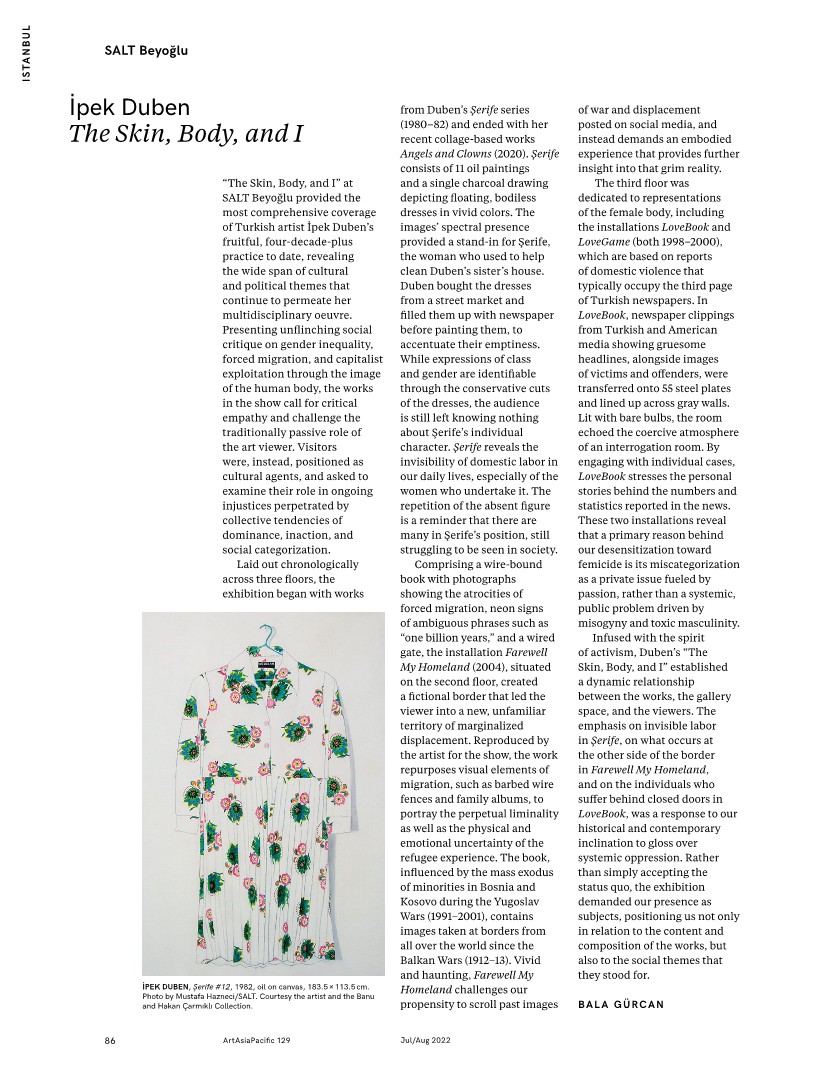

İpek Duben The Skin, Body, and I
Bala Gürcan, ArtAsiaPacific , 129, July/August 2022
"The Skin, Body, and I" at SALT Beyoğlu provided the most comprehensive coverage
of Turkish artist İpek Duben's fruitful, four-decade-plus practice to date,
revealing the wide span of cultural and political themes that continue to
permeate her multidisciplinary oeuvre. Presenting unflinching social critique on
gender inequality, forced migration, and capitalist exploitation through the
image of the human body, the works in the show call for critical empathy and
challenge the traditionally passive role of the art viewer. Visitors
were, instead, positioned as cultural agents, and asked to examine their role in
ongoing injustices perpetrated by collective tendencies of dominance, inaction,
and social categorization.
Laid out chronologically across three floors, the exhibition began with works
İPEK DUBEN, Şerife #12, 1982, oil on canvas, 183.5x 113.5cm. Photo by Mustafa
Hazneci/SALT. Courtesy the artist and the Banu and Hakan Çarmıklı Collection.
from Duben's Şerife series (1980-82) and ended with her recent collage-based
works Angels and Clowns (2020). Şerife consists of 11 oil paintings and a single
charcoal drawing depicting floating, bodiless dresses in vivid colors. The
images' spectral presence provided a stand-in for Şerife, the woman who used to
help clean Duben's sister's house. Duben bought the dresses from a street market
and filled them up with newspaper before painting them, to accentuate their
emptiness. While expressions of class and gender are identifiable through the
conservative cuts of the dresses, the audience is still left knowing nothing
about Şerife's individual character. Şerife reveals the invisibility of domestic
labor in our daily lives, especially of the women who undertake it. The
repetition of the absent figure is a reminder that there are many in Şerife's
position, still struggling to be seen in society.
Comprising a wire-bound book
with photographs showing the atrocities of forced migration, neon signs of
ambiguous phrases such as "one billion years," and a wired gate, the
installation Farewell My Homeland (2004), situated on the second floor, created
a fictional border that led the viewer into a new, unfamiliar territory of
marginalized displacement. Reproduced by the artist for the show, the work
repurposes visual elements of migration, such as barbed wire fences and family
albums, to portray the perpetual liminality as well as the physical and
emotional uncertainty of the refugee experience. The book, influenced by the
mass exodus of minorities in Bosnia and Kosovo during the Yugoslav Wars
(1991-2001), contains images taken at borders from all over the world since the
Balkan Wars (1912-13). Vivid and haunting, Farewell My Homeland challenges our
propensity to scroll past images
of war and displacement posted on social media, and instead demands an embodied
experience that provides further insight into that grim reality.
The third floor was dedicated to representations of the female body, including
the installations LoveBook and LoveGame (both 1998-2000), which are based on
reports of domestic violence that typically occupy the third page of Turkish
newspapers. In LoveBook, newspaper clippings from Turkish and American media
showing gruesome headlines, alongside images of victims and offenders, were
transferred onto 55 steel plates and lined up across gray walls. Lit with bare
bulbs, the room echoed the coercive atmosphere of an interrogation room. By
engaging with individual cases, LoveBook stresses the personal stories behind
the numbers and statistics reported in the news. These two installations reveal
that a primary reason behind our desensitization toward femicide is its
miscategorization as a private issue fueled by passion, rather than a systemic,
public problem driven by misogyny and toxic masculinity.
Infused with the spirit
of activism, Duben's "The Skin, Body, and I" established a dynamic relationship
between the works, the gallery space, and the viewers. The emphasis on invisible
labor in Şerife, on what occurs at the other side of the border in Farewell My
Homeland, and on the individuals who suffer behind closed doors in LoveBook, was
a response to our historical and contemporary inclination to gloss over systemic
oppression. Rather than simply accepting the status quo, the exhibition demanded
our presence as subjects, positioning us not only in relation to the content and
composition of the works, but also to the social themes that they stood for.